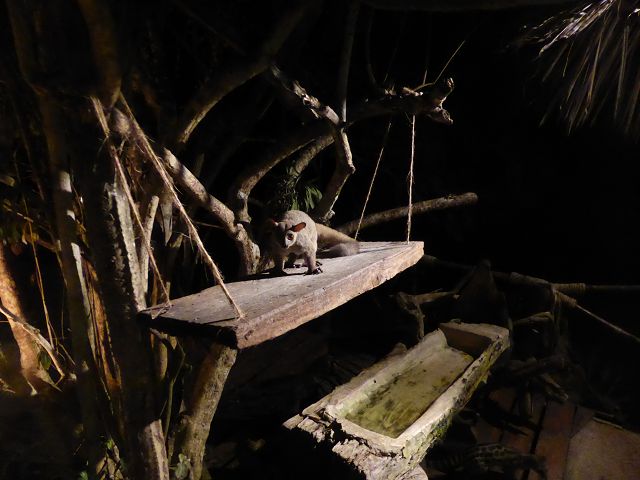 |
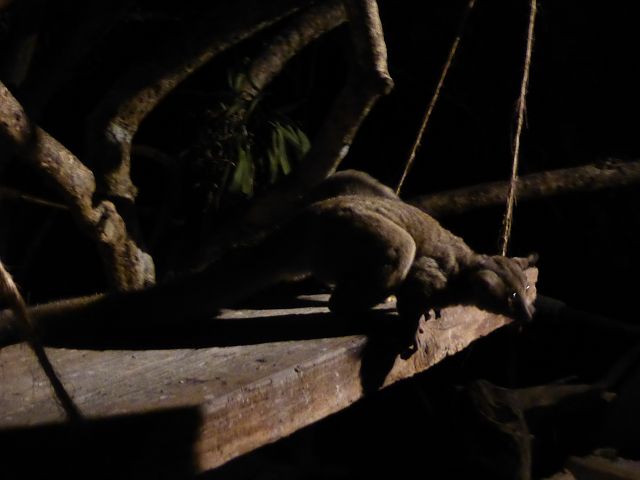 |
|
Bushbaby
Delta Dunes Tanariver Delta Mangrove |
Bushbaby
Delta Dunes Tanariver Delta
|
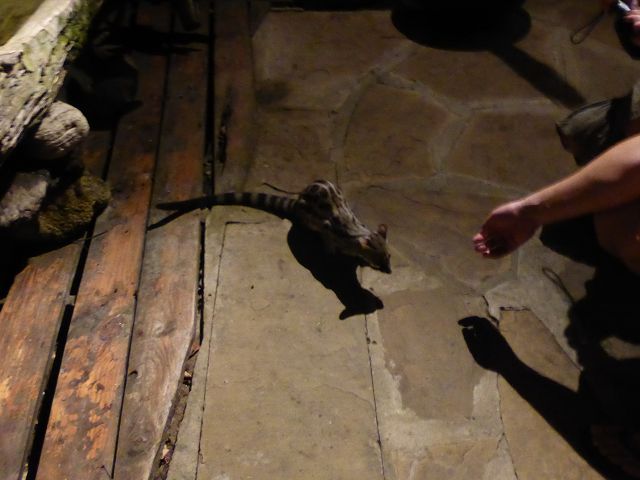 |
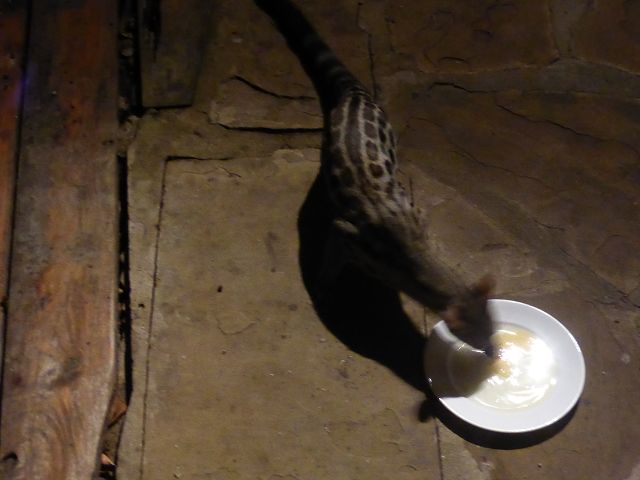 |
|
Ginette
Delta Dunes Tanariver Delta Mangrove |
Ginette
Delta Dunes Tanariver Delta
|
 |
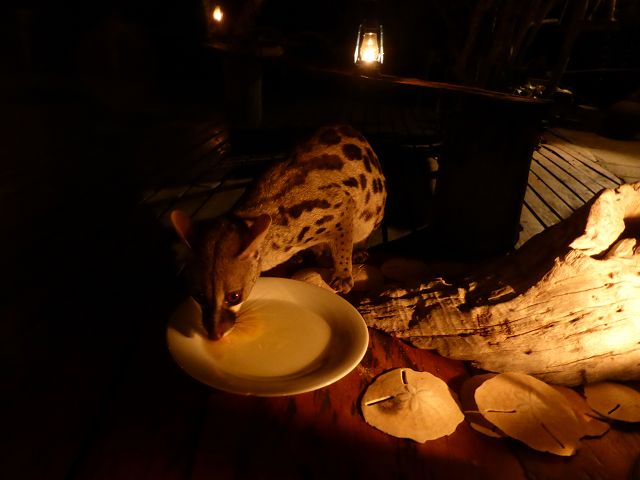 |
|
Genet
Delta Dunes Tanariver Delta Mangrove
Kleinfleck-Ginsterkatze |
Ginet
Delta Dunes Tanariver Delta
Kleinfleck-Ginsterkatze |
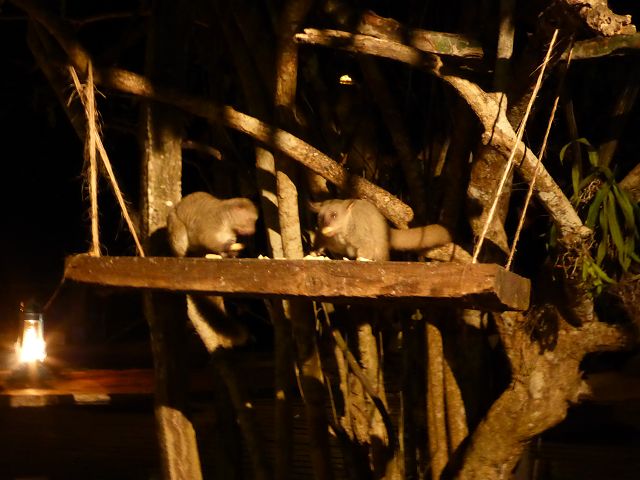 |
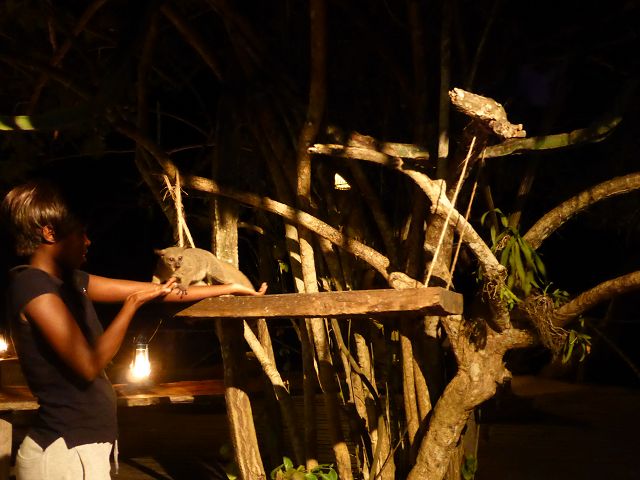 |
|
Bushbaby
Delta Dunes Tanariver Delta Mangrove |
Bushbaby
Delta Dunes Tanariver Delta
|
 |
 |
|
Bushbaby
Delta Dunes Tanariver Delta Mangrove |
Bushbaby
Delta Dunes Tanariver Delta
|
 |
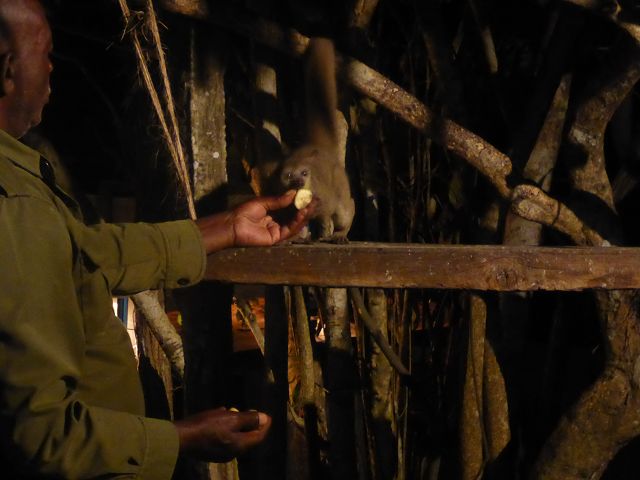 |
|
Bushbaby
Delta Dunes Tanariver Delta Mangrove
Die Kleinfleck-Ginsterkatze (Genetta
genetta), auch einfach Ginsterkatze genannt,
ist ein kleines, nachtaktives Raubtier, das in Afrika und Teilen
Europas beheimatet ist. Sie gehört zur Familie der Schleichkatzen (Viverridae)
und ist bekannt für ihr geflecktes Fell, ihren langen Schwanz und
ihre geschickten Kletterfähigkeiten. Obwohl sie einer Katze ähnelt,
ist sie nicht näher mit Katzen verwandt.
Merkmale der Kleinfleck-Ginsterkatze:
-
Aussehen:
-
Die Kleinfleck-Ginsterkatze hat ein graues
oder gelblich-braunes Fell mit dunklen
Flecken und Streifen, die ihr ein leopardähnliches Aussehen
verleihen.
-
Sie hat einen langen, buschigen Schwanz,
der mit dunklen Ringen versehen ist und ihr beim Balancieren
hilft.
-
Ihr Körper ist schlank und lang, mit kurzen Beinen und einer
spitzen Schnauze.
-
Größe:
-
Die Kleinfleck-Ginsterkatze ist etwa 42–58
cm lang, mit einem zusätzlichen
Schwanz von 39–53 cm.
-
Sie wiegt zwischen 1,5 und 2,5 kg.
-
Lebensraum:
-
Ginsterkatzen sind in einer Vielzahl von Lebensräumen zu
finden, darunter Wälder, Savannen, Buschland und felsige
Gebiete.
-
Sie sind in Afrika weit
verbreitet und kommen auch in Teilen Europas vor,
insbesondere auf der Iberischen Halbinsel und in
Südfrankreich.
-
Verhalten:
-
Ginsterkatzen sind nachaktiv und
verbringen den Tag in Verstecken wie hohlen Bäumen,
Felsspalten oder verlassenen Bauen.
-
Sie sind ausgezeichnete Kletterer und verbringen viel Zeit
in Bäumen, wo sie nach Nahrung suchen oder sich ausruhen.
-
Ginsterkatzen sind Einzelgänger und markieren ihr
Territorium mit Duftdrüsen.
-
Ernährung:
-
Ginsterkatzen sind Allesfresser und
haben eine vielseitige Ernährung, die aus kleinen
Säugetieren, Vögeln, Insekten, Früchten und Eiern besteht.
-
Sie sind geschickte Jäger und verwenden ihre scharfen
Krallen und Zähne, um Beute zu fangen.
-
Fortpflanzung:
-
Die Paarungszeit variiert je nach Region, aber Ginsterkatzen
können sich das ganze Jahr über fortpflanzen.
-
Nach einer Tragzeit von etwa 10–11
Wochen bringt das Weibchen 2–4
Junge zur Welt.
-
Die Jungtiere werden in einem Versteck aufgezogen und sind
nach etwa 6 Monaten unabhängig.
-
Bedrohungen und Schutz:
-
Die Kleinfleck-Ginsterkatze ist derzeit nicht als gefährdet
eingestuft, aber sie steht unter Druck durch Lebensraumverlust und Verfolgung durch
den Menschen.
-
In einigen Regionen wird sie als Schädling betrachtet, da
sie gelegentlich Geflügel angreift.
Interessante Fakten:
-
Ginsterkatzen sind bekannt für ihre Agilität und
können sich schnell und geschickt durch Bäume und Felsen
bewegen.
-
Sie haben eine Duftdrüse am
Schwanzansatz, die sie zur Markierung ihres Territoriums
verwenden.
-
In einigen Kulturen werden Ginsterkatzen als Haustiere gehalten,
obwohl sie nicht domestiziert sind.
Wo kann man Ginsterkatzen beobachten?
-
In Afrika sind sie in
vielen Nationalparks und Schutzgebieten zu finden, darunter Kruger
National Park (Südafrika) und Serengeti
National Park (Tansania).
-
In Europa können sie
in den Wäldern und ländlichen Gebieten der Iberischen Halbinsel
beobachtet werden.
Die Kleinfleck-Ginsterkatze ist ein faszinierendes und
anpassungsfähiges Tier, das eine wichtige Rolle in den Ökosystemen
spielt, in denen es lebt. Ihr geheimnisvolles Verhalten und ihr
einzigartiges Aussehen machen sie zu einem Highlight für
Naturliebhaber und Forscher
|
Bushbaby
Delta Dunes Tanariver Delta
The
Kleinfleck-Ginsterkatze,
also known as the
Small-spotted Genet or
Genetta genetta, is a
fascinating and elusive small carnivorous mammal found in parts of
Africa and
southern Europe. It
belongs to the Genet family
(Viverridae), and its distinctive appearance and behavior
make it an interesting creature to study.
Key Features of the
Kleinfleck-Ginsterkatze
(Small-spotted Genet):
-
Physical Appearance:
-
Size: The
Small-spotted Genet is a small mammal with a body length
ranging from 45 to
65 cm (18 to 26 inches), not including its tail,
which can add another
40 to 50 cm (16 to
20 inches). It typically weighs between
1.5 to 3.5 kg (3.3
to 7.7 lbs).
-
Coat: Its
coat is a
silvery-gray or
yellowish-gray
color, speckled with small, irregular
dark spots
or rosettes,
giving it a camouflaged look, which is where the name
"small-spotted" comes from. The
underside is generally lighter in color, often
white or
pale gray.
-
Tail: The
tail is
long and bushy, often with
dark rings,
which is a distinctive feature of the genets. The tail is
used for balance as they move through the trees or across
various terrains.
-
Face: The
face of the Small-spotted Genet is characterized by
dark markings,
including dark lines running from the eyes to the snout.
They also have
large, round eyes, which give them excellent night
vision.
-
Behavior:
-
Nocturnal:
The Kleinfleck-Ginsterkatze is primarily
nocturnal,
meaning it is most active at night when it hunts for food.
During the day, it rests in hollow trees, crevices, or
burrows.
-
Arboreal:
This species is highly
arboreal,
meaning it spends a lot of its time in the trees, although
it can also move on the ground. It is a very good climber,
using its sharp claws to scale tree trunks and branches in
search of prey.
-
Solitary:
Small-spotted Genets are generally
solitary
animals, except during mating season or when a mother is
caring for her young.
-
Agile:
They are known for their
agility,
being able to leap long distances between branches and
across various terrains.
-
Diet:
-
The
Kleinfleck-Ginsterkatze is
carnivorous,
with a diet that consists mainly of
insects,
small mammals,
birds,
eggs, and
fruits.
They are opportunistic feeders, meaning they will eat
whatever is available, including
reptiles
and small
amphibians.
-
They use their
excellent sense of
smell and
hearing to locate prey at night, and are known to
hunt alone.
-
Habitat:
-
The
Small-spotted Genet is native to a wide range of habitats,
including savannas,
woodlands,
forest edges,
and even semi-arid
regions of
sub-Saharan Africa
and parts of
southern Europe. In Europe, they are found in
Iberian Peninsula
(Spain and Portugal).
-
They prefer
areas with good
cover where they can easily hide and rest during
the day, as well as places with abundant food sources,
including insects and small mammals.
-
Reproduction:
-
The mating
season of the Small-spotted Genet typically occurs during
the wet season
when food is more abundant. After mating, the female gives
birth to 1 to 4
kittens after a gestation period of about
70 to 78 days.
-
The
kittens
are born blind and dependent on their mother, but they start
to explore and become more independent as they grow. They
usually remain with the mother for several months before
striking out on their own.
-
Communication:
-
The
Small-spotted Genet is relatively
silent
but can produce a range of sounds, including
growls,
hisses,
and chirps,
especially when feeling threatened.
-
Marking territory:
Like many other members of the
Viverridae family,
genets have scent glands near their anus that secrete a
strong-smelling fluid. They use this to mark their territory
and communicate with other genets.
-
Conservation Status:
-
The
Kleinfleck-Ginsterkatze (Small-spotted Genet) is
listed as Least
Concern by the
International
Union for Conservation of Nature (IUCN). It is
considered fairly widespread across its range, with stable
populations.
-
However,
habitat loss,
poaching,
and human-wildlife
conflict may threaten local populations in certain
areas. Additionally, in some regions, they are hunted for
their fur or kept as exotic pets.
-
Fun Facts:
-
Despite being
called the "genet" in common English, it is not related to
the domestic cat, although it may appear similar in size and
shape. The genet is a member of the
Viverridae
family, while cats belong to the
Felidae
family.
-
Genets are
known to be able to
spray a
strong-smelling secretion as a defense mechanism, much like
a skunk,
to ward off predators or threats.
Where to See the
Kleinfleck-Ginsterkatze:
-
Africa: In
sub-Saharan Africa, they can be found in a variety of habitats,
ranging from tropical forests to savannas, and even in semi-arid
regions.
-
Europe: In
southern Europe, particularly in the
Iberian Peninsula
(Spain and Portugal), they can be found in woodlands and forest
edges.
|
|
The bushbaby, also known as a galago,
is a small, nocturnal primate native to the forests and savannas of Africa.
These adorable creatures are known for their large eyes, agile movements,
and distinctive calls, which give them their name. Bushbabies are
fascinating animals that play an important role in their ecosystems.
Key Features of Bushbabies:
-
Appearance:
-
Bushbabies are small, with a body length of about 12–20
cm (5–8 in) and a tail that can be just as
long.
-
They have large, round eyes adapted
for night vision, and their ears are large and mobile to detect
sounds.
-
Their fur is typically gray or brown, providing camouflage in their
natural habitat.
-
Behavior:
-
Bushbabies are nocturnal, meaning they
are active at night and sleep during the day in nests made of leaves
or tree hollows.
-
They are incredibly agile and can leap up to 2.5
meters (8 feet) between trees, thanks to their
powerful hind legs.
-
They are social animals, often living in small groups, and
communicate through a variety of vocalizations, including the
distinctive "bush baby" call.
-
Diet:
-
Bushbabies are omnivorous, feeding on
a diet of insects, fruits, tree gum, and small animals.
-
They have a specialized toothcomb (a set of lower teeth) that helps
them scrape gum from trees.
-
Habitat:
-
Bushbabies are found in a variety of habitats, including forests, woodlands,
and savannas across
sub-Saharan Africa.
-
They are arboreal, spending most of their time in trees.
-
Reproduction:
-
Female bushbabies give birth to 1–3 offspring after
a gestation period of about 110–120 days.
-
The young are carried by the mother and weaned after a few months,
becoming independent by the time they are a year old.
-
Conservation:
-
While many bushbaby species are not currently considered endangered,
they face threats from habitat loss due
to deforestation and illegal pet trade.
-
Conservation efforts focus on protecting their natural habitats and
raising awareness about their ecological importance.
Interesting Facts:
-
Bushbabies have a unique way of marking their territory: they urinate on
their hands and feet, leaving scent trails as they move through the
trees.
-
Their large eyes are adapted to see in low light, making them excellent
nocturnal hunters.
-
They are known for their ability to fold their ears back to protect them
while moving through dense vegetation.
Where to See Bushbabies in Africa:
-
Kenya: In forests like Kakamega and Aberdare National
Park.
-
Tanzania: In the coastal forests and woodlands.
-
South Africa: In Kruger National Park and other
forested areas.
-
Uganda: In rainforests like Kibale and Bwindi.
Bushbabies are a delightful and intriguing part of Africa's wildlife. Their
nocturnal habits and elusive nature make them a special sight for those
lucky enough to spot them during a night safari or guided walk.
|
A
bushbaby is a common name for
various species of small primates
found in Africa, particularly
in sub-Saharan Africa.
These nocturnal creatures belong to the family
Galagidae, and their
scientific name is Galago,
although they are often referred to as
galagos or
bush babies due to their
cute, baby-like features. The term "bushbaby" is believed to come from the
high-pitched calls that sound like a crying baby.
Key Features of
Bushbabies (Galagos):
-
Physical Appearance:
-
Size: Bushbabies
are small, typically weighing between
100 to 600 grams (3.5 to 21
ounces), with a body length of about
20 to 30 cm (8 to 12 inches),
excluding their long tail.
-
Eyes: They have
large, round eyes,
which help them see well in the dark, as they are
nocturnal
creatures. Their eyes are adapted for low-light conditions, giving
them excellent night vision.
-
Ears: Bushbabies
have large, pointed ears,
which help them detect sounds in the night. Their acute sense of
hearing is essential for locating prey.
-
Tail: They have
long, bushy tails that help them balance as they leap through the
trees.
-
Fur: Their fur is
typically silky
and ranges in color from
gray to brown,
depending on the species. They also have
white underbellies.
-
Behavior:
-
Nocturnal:
Bushbabies are most active at night, using their excellent night
vision to forage for food and avoid predators.
-
Arboreal: These
creatures are
tree-dwelling (arboreal) and spend most of their time in
the branches of trees, leaping from branch to branch with ease. They
are known for their remarkable ability to leap distances of up to
4 meters (13 feet)
between trees.
-
Social Structure:
Bushbabies are usually
solitary or live in
small family groups,
often consisting of a mother and her offspring. They communicate
with each other through a variety of vocalizations, including
high-pitched calls
and screeches.
-
Diet:
-
Bushbabies are
primarily insectivores,
feeding on insects like
crickets,
grasshoppers, and
cockroaches. They may also consume fruits, nectar, and
small vertebrates, such as
bird eggs or
small lizards.
-
They forage using
their keen sense of hearing to locate insects or other small animals
moving nearby.
-
Habitat:
-
Bushbabies are found
in a range of habitats, including
rainforests,
woodlands, and
savannas across
sub-Saharan Africa.
-
They prefer
tropical forests
with plenty of cover for
climbing and
hunting, but can also live in more open habitats as long as
there are trees for them to inhabit.
-
Species of Bushbaby:
There are over 20 species
of bushbabies, and they vary in size, color, and specific habitat
preferences. Some of the most well-known species include:
-
Gray Bushbaby (Galago
senegalensis): One of the most commonly known species, it
is found in a range of habitats across West and Central Africa.
-
Northern Bushbaby
(Galagoides thomasi): Found in
East Africa, this
species has a more
distinctive vocalization and can be found in
montane forests.
-
Kemp’s Bushbaby
(Galagoides kempfi): A species of
small bushbaby
found in forests in West
Africa.
-
Large-eared Bushbaby
(Galago crassicaudatus): As the name suggests, this species
has larger ears
and is found in forests of
East Africa.
-
Reproduction:
-
Mating: Mating
typically happens during the
breeding season,
with males and females coming together to mate. The female bushbaby
carries the young in her arms or clings to her back for protection.
-
Offspring: A
female bushbaby typically gives birth to
one or two babies
after a gestation period of about
4 months. The
babies are born blind and helpless but are cared for by the mother
for several weeks before they become more independent.
-
Communication:
-
Bushbabies are known
for their loud,
high-pitched calls, which sound somewhat like a crying
baby. These calls are used for
communication
between individuals, particularly in establishing territory or
attracting mates.
-
They may also use
scent marking to
communicate their presence and establish their territory.
Conservation Status:
-
Bushbabies are not
generally considered to be endangered, though some species may face
localized threats due to
habitat destruction and
human encroachment.
Loss of forests and tree cover due to
deforestation could
impact their populations.
-
The most significant
threats to bushbabies include
habitat loss and
hunting. They are sometimes hunted for
meat or
kept as pets in some
cultures, although this practice is less common than with other wildlife
species.
Where to See Bushbabies:
-
Kenya: Bushbabies can
be found in national parks
and reserves like
Tsavo National Park,
Amboseli National Park,
and Mount Kenya National Park.
-
Tanzania: They are
also found in Tanzania's
Ruinsori Mountains and other forested areas.
-
Uganda and
Central Africa:
Various species of bushbabies can be found in forests across Uganda,
Congo, and other Central African nations.
-
South Africa: The
species Galago senegalensis
is found in some areas of
South Africa and
Mozambique.
Fun Facts:
-
Bushbabies are capable of
leaping great distances,
up to 4 meters (13 feet),
due to their strong, long legs and feet.
-
Their large
eyes help them see
well at night, as they are
primarily nocturnal.
-
The name "bushbaby" comes
from their crying baby-like
calls, which are often heard at night.
|
 Safaris
Bergsteigen
Wandern
Inselwandern Weltweit
Safaris
Bergsteigen
Wandern
Inselwandern Weltweit
 Europa
Inselwandern
Europa
Inselwandern
 Städtewandern
Städtewandern
 Paintings
Paintings Dirk Rauschenbach
Dirk Rauschenbach
 Safaris
Bergsteigen
Wandern
Inselwandern Weltweit
Safaris
Bergsteigen
Wandern
Inselwandern Weltweit
 Europa
Inselwandern
Europa
Inselwandern
 Städtewandern
Städtewandern
 Paintings
Paintings Dirk Rauschenbach
Dirk Rauschenbach
![]() 26.07.25 Copyright Dirk
Rauschenbach Koelnerstrasse 293 51702 Bergneustadt
Datenschutzerklaerung 02261 9788972 Mail ccooly(
at) web.de
26.07.25 Copyright Dirk
Rauschenbach Koelnerstrasse 293 51702 Bergneustadt
Datenschutzerklaerung 02261 9788972 Mail ccooly(
at) web.de